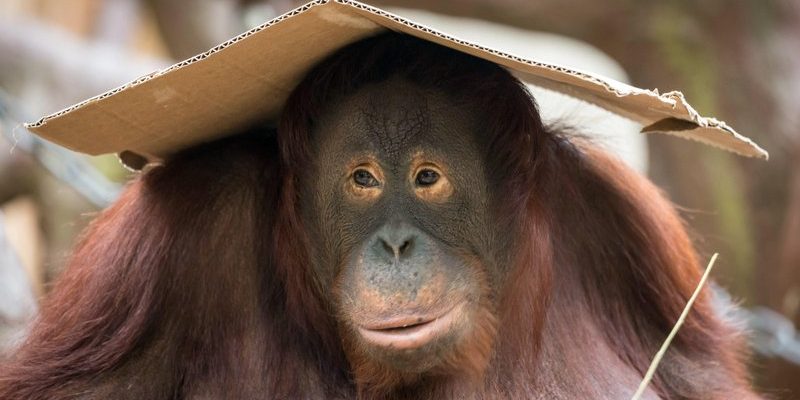
Seeing an orangutan in its natural habitat is a rare treat, but being prepared for such an encounter is crucial. Just like you wouldn’t approach an unfamiliar dog in the park without some caution, the same goes for encountering an orangutan. Here’s what you need to know to handle the situation safely and respectfully.
1. Stay Calm and Assess the Situation
First things first, take a deep breath and try to remain calm. You might feel a rush of excitement or panic, but it’s important to keep your cool. Orangutans, like many animals, can sense emotions. If you’re anxious, they might become uneasy too.
Stand still and observe the orangutan from a distance. Are they foraging for food? Grooming themselves? Or just hanging out? Understanding their behavior will help you gauge whether they’re aware of you or if you’re just a curious observer in their world. Remember, these animals are generally curious but shy.
If the orangutan seems uninterested in your presence, that’s a good sign. Just enjoy the moment quietly, but if they notice you, you’ll want to take some precautions. Avoid making sudden movements or loud noises, as this can startle them.
2. Keep Your Distance
When it comes to wildlife, a respectful distance is crucial. You might be tempted to get closer for a better photo or just to get a better look, but that’s not a good idea. Orangutans can be protective of their space.
Try to keep at least 50 feet away. This distance is not only safer for you but also allows the orangutan to feel secure. If they start moving toward you, back away slowly and calmly. Run or sudden movements could trigger a defensive response.
While it’s exciting to see these creatures, your safety— and that of the orangutan—should always come first. Even if they seem friendly, remember that they are wild animals and can act unpredictably if they feel threatened.
3. Do Not Feed the Orangutan
It might feel tempting to offer food, especially if you have a snack in your bag. However, do not feed the orangutan. Wild animals have natural diets, and giving them human food can disrupt their feeding habits and harm their health.
Additionally, feeding wildlife can cause them to associate humans with food, which is dangerous for both them and people. This type of behavior can lead to conflict between orangutans and humans in the future.
If you feel compelled to do something, consider supporting organizations that work to protect orangutans and their habitats instead. This way, you help them without interfering directly.
4. Observe Quietly
Now that you’re keeping a safe distance and not offering food, it’s time to enjoy the moment. Watch the orangutan as they move about their environment. Are they using tools, like sticks, to get food out of hard-to-reach places? It’s fascinating behavior that shows their intelligence.
Keep your voice down and your movements minimal. You could even try to observe them without your camera out at first. These moments are often fleeting, and sometimes just being present is the most rewarding part of the experience.
And if you do decide to take photos, remember to do it respectfully. No flash, and keep your distance. You’re there to appreciate the beauty of nature, not to interrupt it.
5. Know the Local Guidelines and Laws
Every area has different rules regarding wildlife encounters. Before you set off on your adventure, check local guidelines for interacting with orangutans. Some parks might have strict rules about how close you can get or specific procedures to follow.
Familiarize yourself with the signs, and pay attention to any briefings from park rangers or guides. They’re there to keep you and the animals safe. Following these guidelines not only ensures a healthy interaction but also helps protect these incredible creatures for generations to come.
If you’re in an area known for orangutans, being educated about their habitat and behavior will enhance your experience—and ensure your safety.
6. Reporting an Encounter
If you happen to see an orangutan while hiking or exploring, consider reporting your encounter to the local wildlife authorities. This can help researchers and conservationists keep track of local populations, and it could even help with crucial studies on their behavior and habitat.
You might be wondering why this matters. Well, data collected from encounters can shed light on the health of their population. It also highlights areas where conservation efforts are working—or where they’re needed. Your observation could contribute to meaningful change.
So, jot down the details of your encounter: the location, behavior, and any distinctive features you noticed. This tiny bit of information could be part of a larger conservation effort.
7. Leaving the Encounter Without Disturbance
Once you’ve had your fill of observing the orangutan, it’s time to leave— but do so carefully and without disturbing them. Move away slowly and quietly, giving the orangutan space to continue their activities freely.
As you walk away, take a moment to reflect on the experience. Interacting with wildlife in their natural setting is a privilege, and it’s essential to leave no trace behind. Ensure you don’t litter, and stick to marked paths to minimize your impact on their habitat.
This isn’t just a good practice for orangutans; it’s crucial for all wildlife. When we respect their space, we contribute to a healthier ecosystem.
8. Educate Yourself for Future Encounters
Every wildlife encounter is a learning opportunity. After your experience with an orangutan, consider diving deeper into their behaviors and conservation efforts. Learning more can help you become a more responsible traveler and advocate for wildlife protection.
You might seek out documentaries, books, or even online courses that teach about orangutans and their rainforest habitats. Not only will this enrich your next encounter, but it will also allow you to share your knowledge with others.
Plus, understanding the challenges facing orangutans, like deforestation and illegal poaching, can help you become an informed advocate for their cause. Every little bit counts, and your efforts can make a significant difference.
Encountering an orangutan in the wild is a breathtaking experience that can leave you in awe. By staying calm, keeping your distance, and respecting their space, you ensure a safe and enjoyable moment that benefits both you and the orangutan.
Remember, wildlife encounters are about appreciating nature’s wonders—without intruding. Your actions not only affect your experience but also play a part in protecting these magnificent creatures. Armed with this knowledge, you’re ready to embark on your next adventure with confidence and respect for the wild!

